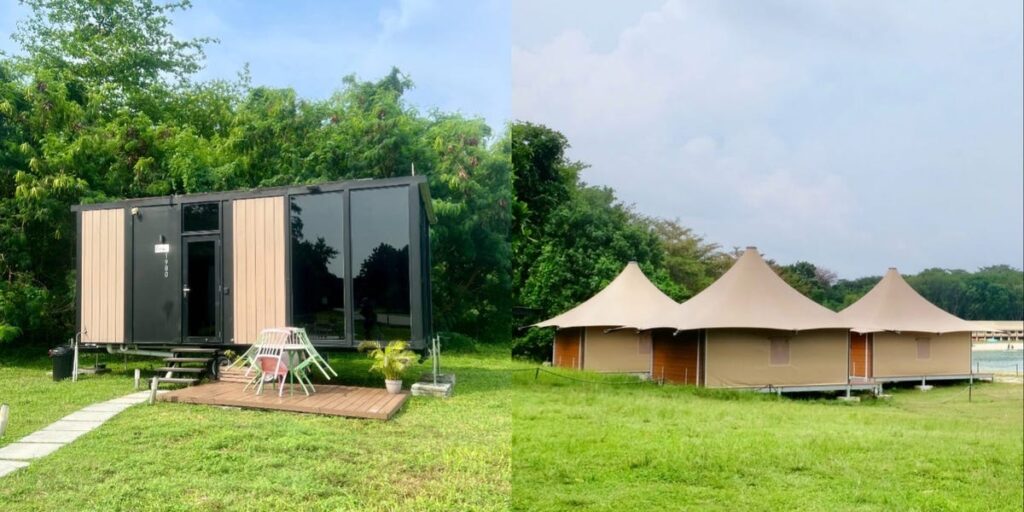- Lazarus Island is 5 miles from mainland Singapore.
- On a recent trip there, I spent one night in a glamping tent and the other in a tiny house.
- The tiny house was more comfortable, but the glamping tent felt like a proper escape from the city.
In August, I hopped on a 20-minute ferry from Singapore to explore Lazarus Island, one of the country’s eight Southern Islands.
This wasn’t my first time on the island — I last visited in 2021. Back then, it had no accommodations, and it was common for visitors to spend the day and head back to the mainland before sunset.
Now, visitors interested in spending a night on the 47-hectare island aren’t required to lug a tent or backpack full of camping gear. Tourists can choose between two recently opened accommodations: a tiny house or a luxury glamping tent.
Big Tiny, a tiny house startup in Singapore, launched Tiny Away on Lazarus in May last year. Into the Woods, run by a couple, Ray Lee and Sam Wong, put up nine tents in February.
Both are part of a government initiative to develop tourism on Lazarus Island. In a media release, Sentosa Development Corporation, an organization under Singapore’s Ministry of Trade and Industry, said the initiative aimed to promote rustic adventure and sustainable tourism on the Southern Islands.
Both options are located around 1,000 feet from each other and are priced at 380 Singapore dollars, or $290, a night after tax and service charges. I stayed a night in each. BI covered the costs of the trip.
Although Singapore has a robust hospitality scene, with two hotels making it on The World’s 50 Best Hotels list in 2024, alternate accommodation options just started taking off in the past few years. From staying in a shipping container hotel in a hell-themed park to glamping in the wild at Singapore Zoo, there are now more options for travelers seeking less ordinary stays.
“After the pandemic, travelers become increasingly experiential-driven for both outbound and domestic travel,” said Prudence Lai, a consultant specializing in travel at market research company Euromonitor, in an email response. Travelers would rather spend on authentic local experiences than spend on tangible goods, she added.
The tiny house was more comfortable
From the outside, the glamping tents looked luxurious. They were equipped with a queen-sized bed, cooking amenities, and air conditioning.
But there was one major inconvenience: Whenever I needed to use the toilet, I had to put on my shoes and trek through the sand to get there.
Due to physical and cost constraints, the Into the Woods’ cofounders decided against installing ensuite toilets. Instead, guests need to take a three-minute walk to the communal toilets, which include four separate showers.
Several guests I spoke to mentioned the inconvenience of trekking the dimly lit path to the toilets in the middle of the night.
In comparison, the tiny house had a surprisingly spacious toilet. The room was clean, comfortable, and tucked away from the rugged outdoors.
The glamping tent offered a more novel experience
With just one convenience store and a water sports center open only on weekends, there’s not much to do on the small island.
The tiny house had a TV with a Netflix subscription. The presence of a screen made it more difficult to unplug, and I found I couldn’t resist indulging in my guilty pleasure: watching a chick flick on Netflix.
By contrast, the glamping tent encouraged me to unplug and try slow living. With an unreliable WiFi connection, I could only turn to the coloring books and journals they provided. Although I initially felt restless, the lack of distractions allowed me to slow down and indulge in a night of self-reflection.
And perhaps because I come from land-scarce Singapore, where small spaces are the norm, living in a tiny house didn’t feel particularly novel.
Staying in a beachfront accommodation, however, was a rare treat. The tents were perched just a couple of feet from the water, and I watched as other guests let their dogs run freely on the sandy shore. Once the last ferry left, it almost felt like I was on a private beach.
Both accommodations provided cooking equipment and a portable guest stove, so guests could cook their own food. During my stay, I opted to cook at Into the Woods and ordered a microwave meal at Tiny Away.
My night in the glamping tent was a refreshing break from my usual city routine
Both accommodations offer a great escape from the hustle and bustle of city life — I felt as though I wasn’t even in Singapore.
Still, the experiences weren’t cheap. The nightly rate at both accommodations was comparable to the rates of some five-star hotels on the mainland — a twin deluxe room at the Shangri-La, for example, costs SG$380 at the time of writing.
Given their premium price points, one night’s stay at both accommodations was enough for me.
Read the full article here


